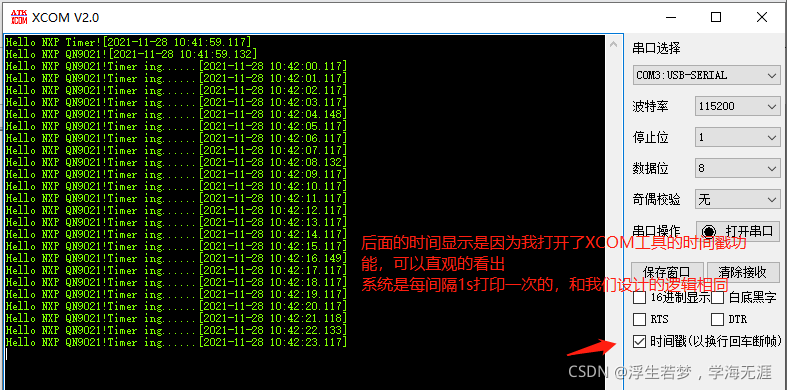本章主要讲解的是QN9021在使用过程中经常使用到的延时函数,由于咱们这颗蓝牙SoC没有SystemTick这个功能,所以就不能使用系统节拍来作为准确的延时工具,这里我推荐的是使用定时器时钟来作为基本的延时函数,实测较为精准。
基本的延时函数定义如下:
/**
****************************************************************************************
* @brief Start the timer delay in micro seconds, until elapsed
*
* @param[in] TIMER QN_TIMER0,1,2,3
* @param[in] pscal timer prescaler value
* @param[in] count counter value
* @description
* This function is used to set a precise delay. HOW TO SET? e.g:
* - if TIMER_CLK = 8000000(8MHz), PSCL_DIV = 7, then
* - PSCL_CLK = (TIMER_CLK) / (PSCL_DIV + 1) = 1000000Hz(1MHz), so
* - delayInUs range: 1us - 4294967295 us (32bit)
* - delayInUs range: 1us - 65535 us (16bit)
*
* timer_delay(QN_TIMER0, 7, TIMER_COUNT_US(100, 7)); // timer delay 100us
*
****************************************************************************************
*/
void timer_delay(QN_TIMER_TypeDef *TIMER, uint32_t pscal, uint32_t count)
{
uint32_t reg;
// set the timer top count value
timer_timer_SetTOPR(TIMER, count);
reg = CLK_PSCL /* set clock source to prescaler clock */
| (pscal << TIMER_POS_PSCL) /* set prescaler value */
| FREE_RUNNING_MOD; /* select free running mode */
timer_timer_SetCR(TIMER, reg); /* must disable timer first */
timer_timer_SetCRWithMask(TIMER, TIMER_MASK_TEN, MASK_ENABLE);
/* wait until delay time has elapsed */
while (!(timer_timer_GetIntFlag(TIMER) & TIMER_MASK_TOVF));
// disable timer
timer_timer_SetCRWithMask(TIMER, TIMER_MASK_TEN, MASK_DISABLE);
/* clear interrupt flag */
timer_timer_ClrIntFlag(TIMER, TIMER_MASK_TOVF);
}例如我这里需要延时1s,则我可以调用如下函数接口,传入相关参数便可实现:
timer_delay(QN_TIMER0, 7, TIMER_COUNT_MS(1000, 7)); //延时1s从此函数可以看出使用的是定时器TIMER0来作为延时函数的时钟基准;预分频系数为(7),实际会在此基础上+1,变为8分频;TIMER_COUNT_MS(1000,7)有两个参数,1000代表延时1000ms,(7)则和前面预分频系数对应,这样就可以实现毫秒级延时了,当然 系统还提供了微秒和秒级别的延时函数
/// Set timer counter top value (TOPR = delayInS * (PSCL_CLK))
#define TIMER_COUNT_S(s, pscl_div) ((s) * PSCL_CLK(TIMER_DIV, pscl_div))
/// Set timer counter top value (TOPR = delayInMs * (PSCL_CLK / 1000))
#define TIMER_COUNT_MS(ms, pscl_div) ((ms) * (PSCL_CLK(TIMER_DIV, pscl_div) / 1000))
/// Set timer counter top value (TOPR = delayInUs * (PSCL_CLK / 1000000))
#define TIMER_COUNT_US(us, pscl_div) ((us) * (PSCL_CLK(TIMER_DIV, pscl_div) / 1000000))只需要对应修改这个参数就可以轻松实现想要的延时效果了~
PS:当然 在使用该延时函数时,可别忘了 初始化TIMER0这个定时器,对应的源码如下:
#include "uart.h"
#include "timer.h"
#include "system.h"
#include "stdio.h"
int fputc(int ch, FILE *f)
{
UartPutc((uint8_t) *&ch);
return ch;
}
//extern void Uart_Process(void);
/**
* @brief Uart example
*/
int main (void)
{
SystemInit();
timer_init(QN_TIMER0,NULL);
uart_init(QN_UART0, __USART_CLK, UART_115200);//初始化串口0
uart_tx_enable(QN_UART0, MASK_ENABLE);
uart_rx_enable(QN_UART0, MASK_ENABLE);
uart_printf(QN_UART0, (uint8_t *)"Hello NXP!\r\n");
while (1) /* Loop forever */
{
printf("Hello NXP QN9021!ing......\r\n");
timer_delay(QN_TIMER0, 7, TIMER_COUNT_MS(1000, 7)); //延时1s
}
}下面我介绍一种在单片机中经常使用到的时间片轮询方法,是基于定时器中断实现的,代码如下:
#include "timer.h"
#include "system.h"
#include "uart.h"
#define TIMER_SPACE 1 //定时间隔
typedef unsigned char u8;
typedef unsigned short u16;
DEVICE_CONTEXT g_Context;
//时间片参数
u8 Time_1ms_flag = 0;
u8 Time_10ms_flag = 0;
u8 Time_20ms_flag = 0;
u8 Time_100ms_flag = 0;
u8 Time_500ms_flag = 0;
u8 Time_1s_flag = 0;
int fputc(int ch, FILE *f)
{
UartPutc((uint8_t) *&ch);
return ch;
}
void timer0_callback(void)
{
static u16 count = 0; //时间计数
count++;
if((count % 1) == 0)//1ms
{
Time_1ms_flag = 1;
}
if((count % 10) == 0)//10ms
{
Time_10ms_flag = 1;
}
if((count % 20) == 0)//20ms
{
Time_20ms_flag = 1;
}
if(count % 100 == 0) //100ms
{
Time_100ms_flag = 1;
}
if(count % 500 == 0) //500ms
{
Time_500ms_flag = 1;
}
if(count % 1000 == 0) //1s
{
Time_1s_flag = 1;
count = 0;
}
}
int main (void)
{
SystemInit();
timer_init(QN_TIMER0, timer0_callback);
timer_config(QN_TIMER0, TIMER_PSCAL_DIV, TIMER_COUNT_MS(TIMER_SPACE, TIMER_PSCAL_DIV));
timer_enable(QN_TIMER0, MASK_ENABLE);
uart_init(QN_UART0, __USART_CLK, UART_115200);//初始化串口0
uart_tx_enable(QN_UART0, MASK_ENABLE);
uart_printf(QN_UART0, (uint8_t *)"Hello NXP Timer!\r\n");
printf("Hello NXP QN9021!\r\n");
while (1) /* Loop forever */
{
if(Time_1ms_flag)
{
Time_1ms_flag = 0;
}
if(Time_10ms_flag)
{
Time_10ms_flag = 0;
}
if(Time_20ms_flag)
{
Time_20ms_flag = 0;
}
if(Time_100ms_flag)
{
Time_100ms_flag = 0;
}
if(Time_500ms_flag)
{
Time_500ms_flag = 0;
}
if(Time_1s_flag)
{
Time_1s_flag = 0;
printf("Hello NXP QN9021!Timer ing......\r\n");
}
}
}
打印如下:

但是我这里发现一个问题 1s的延时时间中间可能会有些许误差,可能和串口传输以及自身的定时误差有关~
在没有很多的单片机内存资源时,我们往往会使用以上的方式进行程序设计,但是在系统资源足够的前提下,FreeRTOS、UCOSII/III、RT-Thread等实时操作系统肯定是更具有优势和价值的!
以上就是本篇文章的全部内容了,有疑问的小伙伴欢迎留言.
如有错误,也欢迎指正
感谢观看!下期再见.





















 1241
1241











 被折叠的 条评论
为什么被折叠?
被折叠的 条评论
为什么被折叠?








